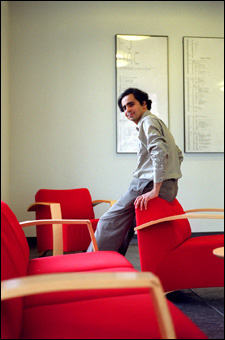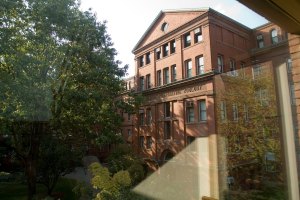Wireless traffic coder smoothes communications snarls:
New DEAS Professor Vahid Tarokh brings wireless expertise to Harvard

You pick up your cell phone, dial, and, if all goes well, you talk, say good-bye, and hang up.
It sounds simple enough, but even the simplest wireless conversation requires the successful resolution of a host of broadcasting and receiving problems, including getting a signal through the building you’re sitting in, over the mountain, and through the high-tension lines to the person you’re talking to.
Helping bring order to this ocean of bouncing, fading, interfering, and overlapping airwaves is Vahid Tarokh, Gordon McKay Professor of Electrical Engineering and Vinton Hayes Senior Research Fellow at the Division of Engineering and Applied Sciences (DEAS).
Tarokh, who came to Harvard last July, is one of the world’s foremost experts in wireless communications. He holds numerous patents and is credited with coming up with complex mathematical formulas – called space-time codes – that help coordinate cellular signals, cut down on interference, and boost signal strength.
In short, he figured out how to make sure your voice is heard loudly and clearly enough at the other end so that cell phone use isn’t merely an exercise in frustration. His work has been incorporated into industry standards around the world. One estimate suggested more than 1 billion handsets would incorporate space-time codes by 2006.
“Professor Tarokh’s work is central to the field of communications, which is a core discipline in the field of electrical engineering (EE),” said DEAS Dean Venkatesh Narayanamurti. “Wireless communication is by far the fastest-growing area in EE. Professor Tarokh has brought instant visibility in this important area to Harvard.”
Space-time codes are Tarokh’s solution to one of the central problems of wireless communications: how to send and receive a clear signal. The more powerful a signal is, the clearer it is, but federal regulators limit the broadcasting power of communications base stations. That means that sometimes there isn’t enough power to send a clear signal through the varied, distant, and obstacle-laden world.
Tarokh himself says it’ll never be possible to create the perfect wireless system. Still, he said, people want the clarity you get with a wired telephone along with the freedom of wireless.
“There will always be fading, always interference, in wireless systems,” Tarokh said.
More antennae
Though wireless may never be perfect, Tarokh figured out a way to improve things by sending signals from several antennae instead of one. His space-time codes help a single cell phone combine those multiple signals back into just one – the voice at the other end. The result is a stronger and clearer signal – and conversation.
“I think I owe my career to this invention,” Tarokh said.
Tarokh did his main work on space-time codes during his four years at AT&T Labs. He left AT&T in 2000, however, because he wanted to expand his work to new areas. He’s currently working in several areas, including wireless LANs, or local area computer networks, like the wireless network that exists at Harvard. Tarokh said setting up a LAN requires a delicate balance between the power of the system and the number of users. Efforts have been tried to increase a LAN’s range by boosting power with a directional signal.
That can backfire, however, because it provides a less powerful signal to users not in the path of the directional beam. This low-power area can appear to be an available idle channel, prompting simultaneous transmissions from several users that can collide and slow the whole network.
Tarokh is working on a way to expand the range of LANs while reducing the traffic jams among the increased number of users that would be present in a bigger area.
“I kind of am a problem-solver, not just a wireless person,” Tarokh said. “I’m not the kind of guy who likes to do the same thing over and over again. I couldn’t see myself doing space-time coding for 25 years.”
From AT&T, where he had become head of the department of wireless and signal processing research, Tarokh became an associate professor at the Massachusetts Institute of Technology. He left M.I.T. to come to Harvard last summer.
Tarokh, who grew up in Iran before moving to Canada in the 1980s, said he’d always had a love of mathematics. He received a master’s degree in mathematics in 1992 from the University of Windsor in Ontario. He did further graduate course work in mathematics and computer science at the University of Toronto before deciding he wanted to do more physics. He switched to an electrical engineering program at the University of Waterloo in Ontario, receiving a doctorate in electrical engineering in 1995.
“My idols were the [James Clerk] Maxwells of the world, who could write equations that have physical meaning,” Tarokh said, adding that theories created by physicists like Maxwell, known for his work on electromagnetism, were impressive because they spawned generations of research.
After graduating from the University of Waterloo, Tarokh became a visiting assistant professor at the University of Illinios at Urbana-Champaign until he left for AT&T Labs in 1996.
Tarokh has 15 patents either issued or pending. He has received several prestigious awards, including the 2001 Alan T. Waterman Award, the highest honor given by the National Science Foundation for scientists and engineers under age 35. His invention of space-time coding won the 1999 IEEE Information Theory Society Prize Paper Award.




